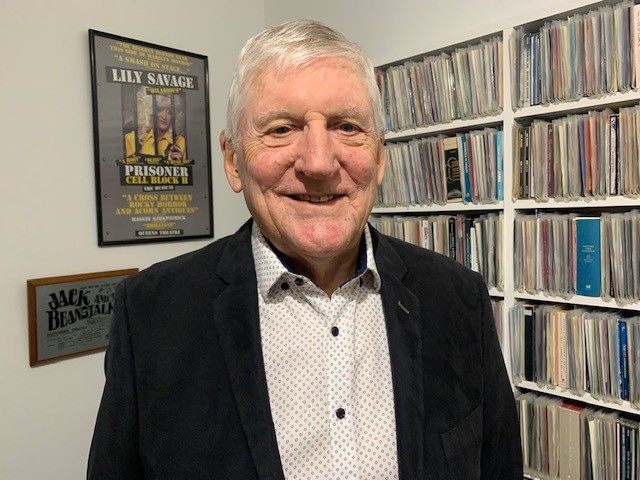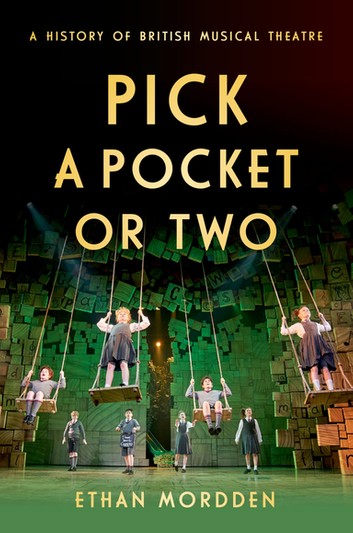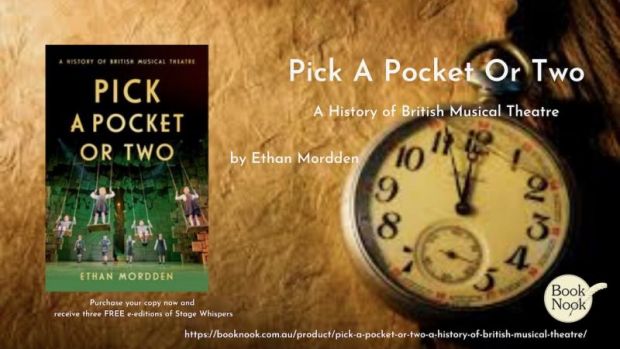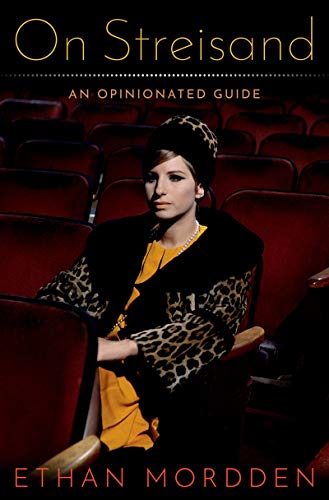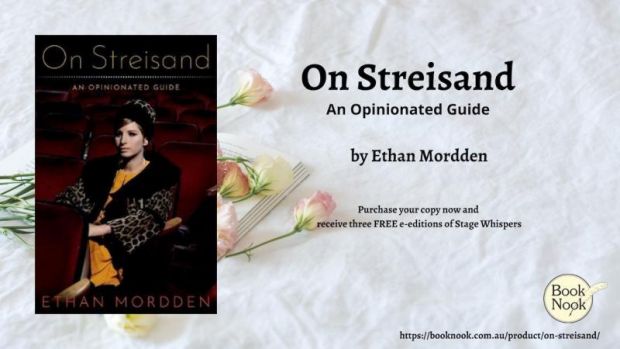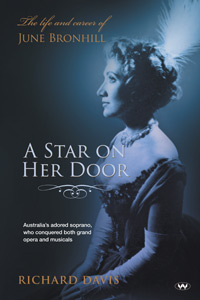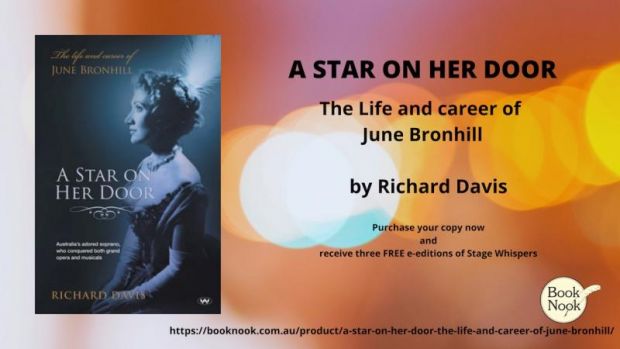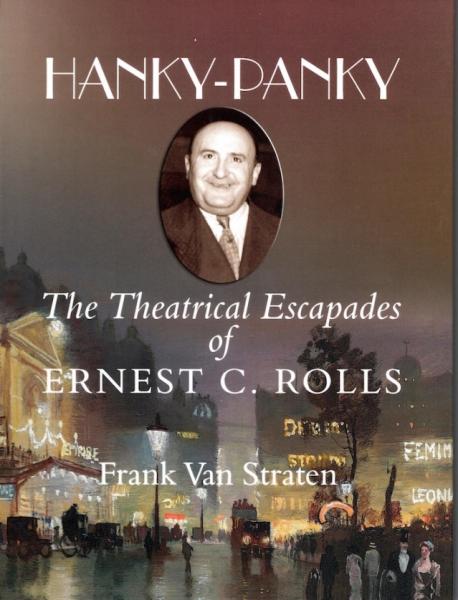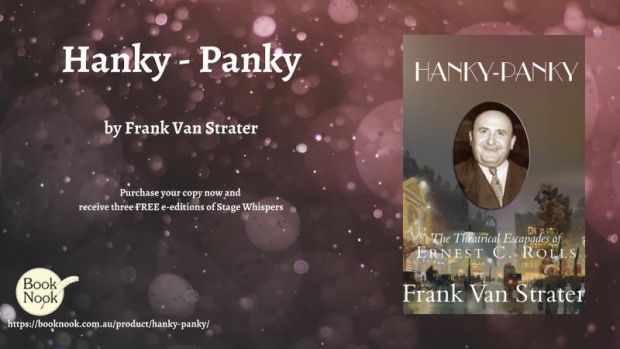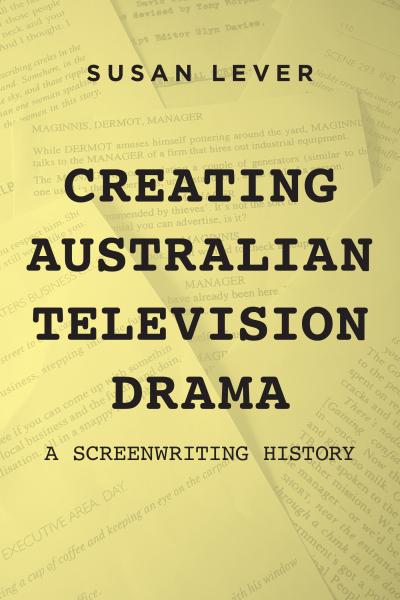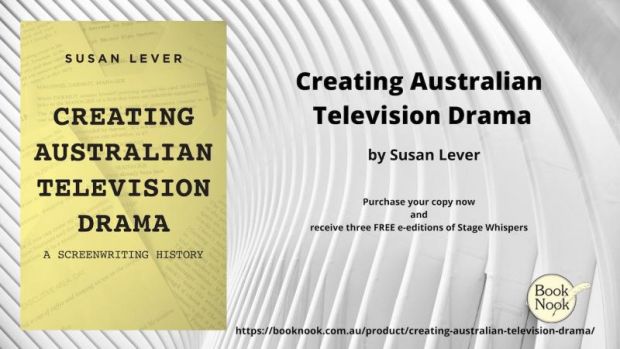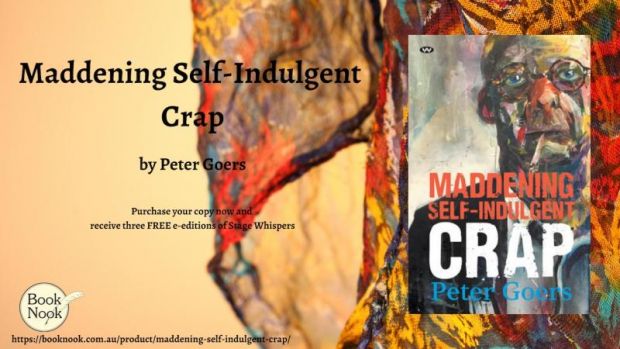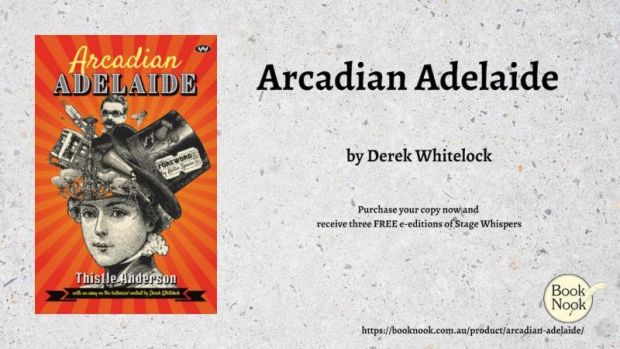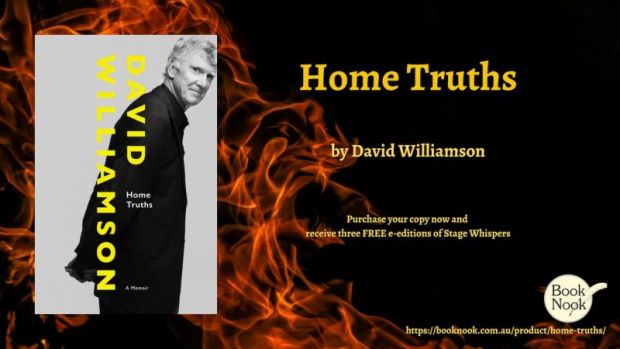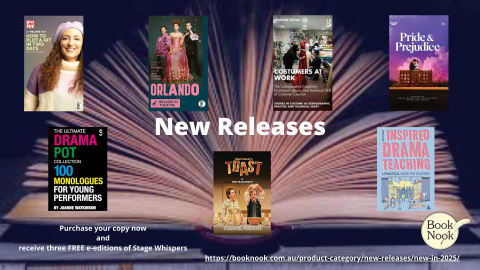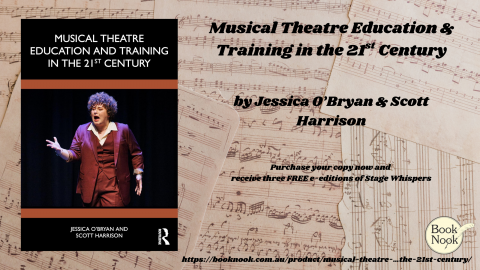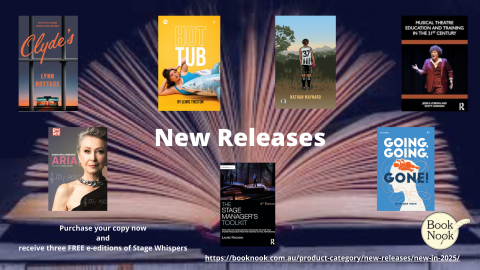Stage to Page 2021
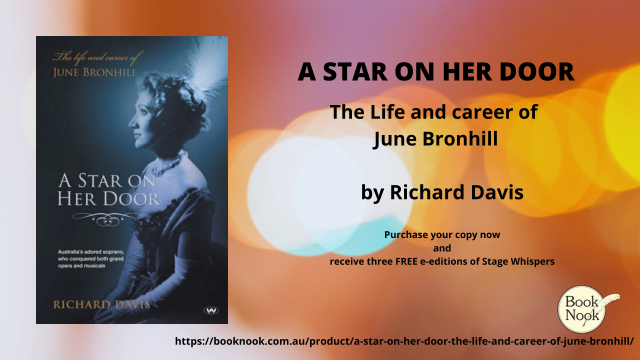
We've collected together all of Peter Pinne's book reviews from the 2021 editions of Stage Whispers, to give you a run-down on some great Performing Arts reading.
Pick A Pocket Or Two - A History of British Musical Theatre by Ethan Mordden (Oxford US$29.95)
Back in Broadway’s ‘Golden Age’, whenever I was asked what my favorite musicals were, I would always reply The Boy Friend and Oliver! They both had good books, literate and amusing lyrics, and tunes you could hum, and these are the two musicals that are given more space than any others in US author Ethen Mordden’s history of British Musical Theatre.
The Boy Friend broke an almost twenty-year drought of British musicals on Broadway, becoming the first West End musical to appear there since Noël Coward’s Conversation Piece in 1934, while nine years later Oliver! would take out the Tony for Best Score. These and other facts are wonderfully elucidated in Mordden’s well-known perceptive and waspish tone, which has become standard for his Broadway volumes. This is the first time, though, that he’s dipped across the pond to England.
Starting with John Gay’s The Beggar’s Opera, which he classifies as the first ‘musical’, he follows with a chapter on Gilbert and Sullivan, and essays on Noël Coward, Ivor Novello, Sandy Wilson, Julian Slade and Lionel Bart, until reaching the pop opera period and everything after, which takes in Lloyd Webber, Claude-Michel Schönberg and Alain Boublil, Elton John and Tim Minchin.
It’s a vast canvas and the last thirty years are squeezed into the same number of pages as he devotes to G&S. Some shows get a lengthy analysis, while others barely rate two lines. Throughout the book he introduces a ‘chart of shows’ for all the important composers, which is a useful guide to their oeuvre.
Mordden’s admiration for the work of Coward is unbounded, with good things to say even about Sail Away - questioning why it took so long for the amateur rights to be released when the work has obvious appeal for the world’s Operatic Societies.
On Coward, he says, ‘The best of Coward’s writing is fast and smart, essential gay qualities, and while we can’t penetrate the mystery of chromosomes, the gay ID in art, is, like jazz, indefinable yet unmistakable.’ On Novello he asserts, his ‘seven Big Sing musicals from 1935 to 1949 stand among the British Theatre’s most imposing body of work.’ On Bart, ‘Oliver!’s glory remains its score, a unique creation that doesn’t sound like Bart’s other titles, much less anyone elses.’
His accolades continue for Wilson’s The Boy Friend, ‘easy to stage and easy to enjoy, because the text is amusing and the next number is never more than minutes away,’ and Slade, ‘all along, those simple songs that are easy to sing kept Salad Days joyous.’
On Lloyd Webber’s The Phantom of the Opera he says, ‘Maybe the biggest surprise is how guiltlessly romantic the music is with the gala, long-lined melodies that Lloyd Webber keeps pulling out like a magician producing his rabbit.’
Broadway tunesmiths tried their luck in London in the twenties, Jerome Kern with The Cabaret Girl, and Rodgers and Hart with the Cicely Courtneidge vehicle Lido Lady, while operetta shone in all its glory in The Maid of the Mountains and Chu Chin Chow, the longest runner in London at 2,235 performances, during the First World War, until Salad Days knocked it off its pedestal in the fifties with 2,283 performances.
Vivian Ellis makes an appearance in the twenties and continues through the next three decades, producing a winner in Bless the Bride - ‘The Bride’s score is not only melodious but ingenious, as Ellis devised two completely different soundscapes for it – stately and diatonic for the Britons, and lush and chromatic for the French.’
Mordden lauds the Soho musicals of the fifties - Expresso Bongo, Make Me An Offer, and especially The Crooked Mile - and finds much to admire in The Hired Man’s (1984) - ‘powerful male choruses, Irish in tone but bearing a Welsh solidarity in the harmony.’
Australian composer Charles Zwar makes it into the pages with Arthur Askey’s Bet Your Life (1952), and coming under the justification of ‘colonial’, Peter Stannard and Peter Benjamin’s Lola Montez (1958) gets a guernsey (‘marvellous score’) even though it was never produced in London.
Like all of Mordden’s efforts it’s a good read, not a research tome as its documentation is thin (look to Kurt Ganzl’s The British Musical Theatre for that, or even Adrian Wright’s A Tanner’s Worth of Tune or Must Close Saturday) but above all it’s entertaining. It comes with a very good and detailed discography, an index, and 14 pages of B&W and color plates.
Click here to order your copy at Book Nook
On Streisand – An Opinionated Guide by Ethen Mordden (Oxford US$21.95)
Based on a concept he created in 2015 for a similar book on composer Stephen Sondheim, Ethan Mordden (my, he’s been a very busy boy) looks at the career of Barbra Streisand in four-parts.
If anyone deserves the accolade ‘Star’, Streisand has certainly earned her spot in the firmament, and this book only endorses the diva’s brilliant career. Mordden opens with a quote from her, when she said, ‘I became a singer because I couldn’t get a job as an actor’ and then proceeds to document her time on Broadway, her movie work (which co-existed alongside her recording work), adding her excursions into television. He says whilst none of her movies are thought to ‘stand in the top class of American cinema’, she is arguably ‘the greatest popular singer America has ever produced.’
Right on both counts. She is a phenomenon - still producing million-dollar selling recordings after six decades.
Streisand got her start when she interned in summer stock at fifteen, and then three years later played Hortense, the French maid, in Sandy Wilson’s The Boy Friend. There’s also an unconfirmed anecdote of her appearing as Babe in her school production of Good News.
She met her first muse and lover Barry Dennen when they appeared Off-Broadway in The Insect Comedy (1960), and he introduced her to the recordings of Libby Holman, Ethel Waters and Billie Holiday.
Dressing in thrift shop clothes, she began making appearances on late-night TV, most memorably captured in her duet with Judy Garland duet of ‘Happy Days Are Here Again’ (available on YouTube).
Her stint in I Can Get It For You Wholesale produced the kooky ‘Miss Marmelstein’, but it was Funny Girl that set her on the road to stardom, with the subsequent movie version bringing her box-office gold and an Oscar. ‘People’ became one of her classics, although Bob Fosse originally wanted to cut it.
Was she too young at 27 to play Dolly Levi in the movie of Hello, Dolly!? Mordden doesn’t think so, believing there was no one else who would have done it better.
The best of her cinema career is linked to performances with a series of Hollywood golden-boy hunks - Robert Redford (The Way We Were), Ryan O’Neil (What’s Up Doc?), Nick Nolte (The Prince of Tides) and Jeff Bridges (The Mirror Has Two Faces). They’re all given multiple page space, as is Yentl, the story of a ‘young Jewish woman in the old country who cross-dresses in order to study rather than keep house.’ She only got the project off the ground because she agreed to make it a musical.
What made her early TV specials - My Name Is Barbra and Color Me Barbra - ‘special’ is discussed at length, as is the only flop in the series, The Belle of 14th Street, an excursion into vaudeville at the turn-of-the-century.
On Streisand is astute, informative, and totally absorbing in its dissection and explanation of this legendary ‘diva’s’ talent. It comes with a bibliography, index, and a 14 page color and B&W picture essay.
Click here to order your copy at Book Nook
A Star On Her Door – The Life and Career of June Bronhill (Wakefield Press)
After writing definitive biographies of Stuart Challender, Marjorie Lawrence, Geoffrey Parsons and Eileen Joyce, author Richard Davies has now turned his attention to June Bronhill. She is a more than worthy subject, with a career that covered grand opera, operetta, musicals, straight plays, variety, radio, concerts, television and recording.
Bronhill was born June Mary Gough in Broken Hill, NSW, 26 June 1929, the last child in the large family of George and Daisy Gough, who already had four daughters and a son. She studied music with Marianne Mathy, a former coloratura soprano and it was Mathy who helped June select a new performing surname, an abbreviation of her hometown Broken Hill.
Her first stage performances were for the Rockdale Opera Company, Sydney, where she sang in Hansel and Gretel and A Masked Ball. Playing the female lead Margo Bonvalet in The Desert Song for Petersham Musical Society, she met her first husband, Brian Martin, a sales representative for Berlei Corsetry Company. Martin had a daughter, Faith, by a previous marriage.
In 1952 they sailed for London, where Bronhill was to study singing with Italian Dino Borgioli. She auditioned for Sadler’s Wells and very soon became their leading soprano, appearing as Barbarina in The Marriage of Figaro and Adele in Die Fledermaus. She did two Menotti operas on TV, The Saint of Bleeker Street and The Telephone, before starring in one of the biggest successes of her career, The Merry Widow.
This led to a string of EMI recordings of operettas - Land of Smiles, Roberta and Orpheus in the Underworld - which she performed to great success on stage.
She returned to Australia with the Widow and followed with the role of Maria in Rodgers and Hammerstein’s The Sound of Music, playing it to enormous success throughout Australia and New Zealand, which was where she met her second husband, Richard Finney. They had a daughter Carolyn, but the marriage was in trouble, with infidelity on both sides. They divorced in 1971.
In 1964 Bronhill had an enormous success as poet Elizabeth Barrett in Robert and Elizabeth opposite Keith Michell as Robert Browning. After playing 948 West End performances, with Kevin Colson succeeding Michell as Browning, Bronhill toured the show to South Africa and Australia. It was a success in Melbourne, but flopped in Sydney.
Bronhill was devastated and ended up working at the Lido nightclub, Melbourne, to earn money. She returned to London for a provincial tour of Novello’s The Dancing Years which did a London stint, and also tours of Coward’s Bitter Sweet, and Novello’s Glamorous Night and Perchance to Dream.
In 1981 The Sound of Music beckoned again, only this time she played the Mother Abbess opposite Petula Clark as Maria. Following the season she returned to Australia to find her partner at the time, Freddie Wrennell, who had access to her bank accounts, had failed to pay her tax bills and drained her account, having spent the money on himself and lavish parties. Broke, she found work as Mrs Pearce in My Fair Lady, Nunsense, and Arsenic and Old Lace with Gwen Plumb.
She began losing her hearing in 1992. Roles became more infrequent and eventually she went into aged care. She died in 2005. The book comes with lots of B&W photos and a loving foreword by her successor, Marina Prior. ‘She was also a star of the “old school” and an incandescent light on stage, able to hold thousands in her thrall. We will not see her like again. Brava, dear June.’
Click here to order your copy at Book Nook
Hanky-Panky – The Theatrical Escapades of Ernest C. Rolls by Frank Van Straten (Australian Scholarly Publishing)
Of all the rogues and vagabonds in Australia’s theatrical past, Ernie Rolls would have to be the most colorful, with a flair for exaggeration and careless with the truth. Frank Van Straten has done a mighty job of separating fact from fiction in this new book, dedicated to a long unjustly-forgotten theatrical entrepreneur.
Rolls’ Australian sojourn lasted fifteen years, from 1925 until 1940, and during that time he produced some of the most lavish Ziegfeld-type revues Australia has ever seen. His recipe for success was songs, dances, comedy and girls - lots of beautiful girls - the more scantily clad the better.
Ernest C. Rolls, or to give him his real name, Joseph Adolphe Darewski, was born 6 June 1890, according to Van Straten, most probably in Vienna, to a large musical Jewish family who had originally come from Poland. His father, Eduard, sang tenor in opera, whilst his siblings Herman and Max became composers of note. The family moved to Manchester, England in 1894, and later to London in 1899.
In his late teens, Rolls took on the mantle of producer. His first ‘star attraction’ was Eva Moore, a respected actress and future mother-in-law of Laurence Olivier. When he didn’t pay her the agreed fee she took him to court. It was the first, but not the last time, he was the ‘star attraction’ in a courtroom.
Rolls’ first London production was the revue Oh Molly, which formed half of a variety bill at the London Pavilion in 1912. He followed with some ten full-length revues in London and the provinces, which included Ragmania (1913), Full Inside (1914), and the all male drag revue Splinters (1919).
When Full Inside opened in London, singer and comedienne Jennie Benson joined the cast. From that moment on Rolls’ and Benson’s careers were linked to each other. They married in 1921 and remained together for the rest of their lives, despite going through turbulent financial times and the ignominy of Rolls’ infamous public disgrace when he exposed himself to two women.
Benson had been to Australia for the Tivoli Circuit in 1909 and loved it, so when another offer came to tour ‘down under’ in 1925 she jumped at the chance. Rolls was her conductor and manager. The next fifteen years saw Rolls become a permanent fixture on the theatrical scene producing his forte, lavish Ziegfeld-type revues and musicals - Sunny (1927) and Gladys Moncrieff in Rio Rita (1928) amongst others.
In the early thirties, in league with the Fuller organization, Rolls set-up shop at the recently renamed Apollo Theatre, Melbourne (formerly the Palace), and produced, Rhapsodies of 1935, with Strella Wilson and Roy Rene ‘Mo’, and Jack O’Hagan’s musical Flame of Desire (1935).
In 1938, Rolls managed to inveigle his way onto the J.C. Williamson’s board, which later found him appointed co-managing director. Under his reign JCW produced The Women to great success around the nation, but I Married an Angel performed dismally, running a mere 29 performances. He and Benson returned to the UK in 1940, where his credits included wartime provincial touring revues and a last ditch effort to revive music-hall at the Metropolitan, Paddington.
He died in 1964, whilst Benson died in 1979 aged 95. He was not always liked: Viola Tate in her book A Family of Brothers disparagingly referred to him as ‘a Polish Jew’, but Roy Rene in Mo’s Memoirs said, ‘I think Rolls was one of the greatest showmen this country has ever seen.’
It’s an engaging biography of Australia’s own Max Bialystock, or ‘Flash Ernie’ as he was known, and is as flamboyant and salacious as the man himself. The book comes with some marvelous images, especially the art-deco program covers for Tout Paris, Rhapsodies of 1935 and Vogues of 1935 with their racy near-naked depictions of young women. It’s well documented and a riveting read.
Click here to order your copy at Book Nook
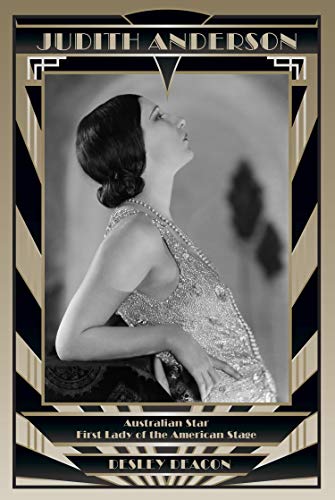
Judith Anderson – Australian Star, First Lady of the American Stage by Desley Deacon (Kerr)
Desley Deacon has frequently written about Judith Anderson (she authored Anderson’s biography for the Australian Dictionary of Biography 2016), so she’s the perfect person to pen a biography of the star.
Most Australians are unaware that Anderson was born in Australia, and most Americans don’t know she’s not American. Deacon’s superbly written and illustrated book redresses the situation.
Anderson (originally named Frances), the youngest of four children, was born in Adelaide in 1897 to Jessie Margaret (nee Saltmarsh), a former nurse, and Scottish-born James Anderson, a sharebroker and pioneering prospector. Her father made and lost fortunes and left the family to try his luck on the Kalgoorlie goldfields when Frances was six. Her mother, no wilting violet, took control of the family and Frances’ destiny. She saw the flame of ambition in Frances and encouraged it.
Frances studied singing and elocution. In 1909 at age 12 she won an elocution award at Ballarat’s Royal South Street Eisteddfod, and at 15 made her professional stage debut (as Francee Anderson), playing the ingénue role in A Royal Divorce opposite popular Scottish actor Julius Knight. Later in life she acknowledged that Knight gave her the foundation of her acting skills.
With the support of her mother, she left Australia to go to America when she was 19 and never returned to live in Australia again. She sought fame in Hollywood, but, not being a ‘typical Hollywood beauty’, failed. She tried New York and after constant rejection found work appearing as Joanna Trout in a tour of Dear Brutus. The role had previously been played by Helen Hayes.
She changed her name to ‘Judith’ and had her first Broadway success playing a vamp in Cobra, where she had to wear her own clothes. The dress she wore, by New York designer Milgram, caused a sensation and from that moment on Anderson became a fashion icon, frequently appearing in the pages of Vogue.
She made her name when she took over from Lynne Fontanne in Eugene O’Neill’s nine-act Strange Interlude for the Theatre Guild. It was a marathon role which she played for two years - eighteen months on Broadway and six months on the road. It proved she was a serious emotional actress. She played Gertrude to John Gielgud’s Hamlet (1936) and they received fifteen curtain-calls on opening night (‘the best Queen in Hamlet anyone in this generation has seen’) and joined London’s Old Vic, where she starred opposite Laurence Olivier as Lady Macbeth (‘she takes the stage with authority’).
In 1947 she triumphed, winning a Tony in the title role of Euripides’ Medea in a version written by Californian poet Robinson Jeffers, produced by John Gielgud who played Jason (‘a landmark in the theatre … Perhaps Medea was never fully created until Miss Anderson breathed immortal fire into last evening.’ Brooks Atkinson, New York Times). She later returned to Medea in 1992, playing the Nurse opposite fellow Australian Zoe Caldwell (who had a small part in the production she toured to Australia in 1955-56) in the title role.
In 1952 Anderson suffered a personal setback when her lawyer and financial advisor, T.H. Canfield, committed suicide amidst revelations of large-scale embezzlement. It almost destroyed Anderson, who lost all her savings.
Her first film success was in Blood Money (1933), which featured cross-dressing women, rough sex and elegant clothes. Her greatest film success was as Mrs Danvers in Alfred Hitchcock’s screen adaptation of Rebecca, with Joan Fontaine and Laurence Olivier. She is still remembered today for her role of the housekeeper who is the personification of evil. Because of this role she’s become something of a poster-girl for lesbians in the movies, although in real-life her sexual persuasion was decidedly straight.
Other notable movies included Kings Row (1942), Laura (1944), The Strange Loves of Martha Ives (1946) and Cat on a Hot Tin Roof (1958). Later, at the age of 87, she appeared in Star Trek III: The Search for Spock, as the Vulcan High Priestess T’Lar.
Her many television credits include The Moon and Sixpence (1959) with Laurence Olivier, an Emmy winning Lady Macbeth in the TV movie Macbeth (1960), and three years as matriarch Minx Lockridge on the daytime soap Santa Barbara (1984-1987), where she received a salary of $5,000 an episode. At the time she was 90.
She returned to Australia for J.C. Williamson’s in 1927 with three plays - Cobra, The Green Hat and Noël Coward’s Easy Virtue. They were not a success. The critics thought Cobra was ‘sordid’. She again toured Australia in 1955 with Medea. This time she received accolades, and later, in 1966, more high praise for The Oresteia at the Adelaide Festival of Arts. (Not in the book is the fact that she returned to Australia in 1975 to appear in Terry Bourke’s western-horror movie Inn of the Damned, and also filmed an episode of Crawford Productions’ Matlock Police.)
Although she had numerous affairs throughout her life, she only married twice. The first time was to Benjamin Harrison Lehmann, an English professor at the University of California, which expired after two years, while the second, to Luther Greene, a theatre producer, lasted on and off for five years. She quipped ‘neither experience was a jolly holiday’.
She was made a Dame Commander of the British Empire in 1960, and just prior to her death received the Companion Order of Australia in 1992. Deacon’s chronicling of her career is masterful. She vividly brings to life the eras in which Anderson worked, her social set, her lovers, and her friends. It’s a loving tribute.
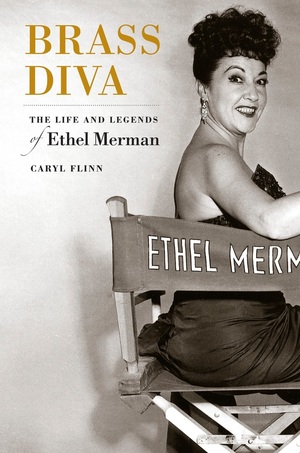
Brass Diva – The Life and Legends of Ethel Merman by Caryl Flinn (University of California Press $88.40)
A friend gave me a copy of this book and said it was the best biography he had ever read. Well, whether it’s the best is debatable, but it’s one of the most comprehensive I’ve ever read, crossing every ‘t’ and dotting every ‘i’ in Merman’s long and remarkable career. The author, Caryl Flinn, not only interviewed stars who had worked with Merman, but her family and friends, and for the first time did exhaustive research on her fifty-plus scrapbooks, housed in the museum of the City of New York. Collected and maintained by her father for the bulk of her career, these scrapbooks offer an unusually detailed history of the star’s appearances, awards, and film and stage performances.
Of course we all know that Merman became an overnight sensation when she sang ‘I Got Rhythm’ in the Gershwin Brothers’ Girl Crazy in 1930, that she starred in Irving Berlin’s Annie Get Your Gun in 1946, and that she was the original Mama Rose in Gypsy in 1959.
We also know that she had a foul mouth, a fondness for dirty jokes, and her fourth marriage to Ernest Borgnine lasted 38 days.
What we didn’t know is that Merman suffered spousal abuse from her third husband Bob Six, and that at one time he pulled a gun on her.
Merman was a workaholic. In the early days she would shoot two-reeler shorts during the day, appear on stage at night, and after the show follow with a performance at a supper show. It was a brutal schedule but her stamina is what saw her become the icon she was.
Merman starred in 13 musicals on Broadway, and every one of them was a hit. Even Happy Hunting, which she claimed had an inferior score, provided her with two hit songs. Cole Porter wrote five shows for her - Anything Goes, Red Hot & Blue, Dubarry Was a Lady, Panama Hattie and Something for the Boys, Irving Berlin two - Annie Get Your Gun and Call Me Madam, and although she missed out on doing a Rodgers and Hammerstein vehicle, they were her producers on Annie Get Your Gun.
The songs she introduced that became hits are like a Broadway classics songbook. She was famous for being able to belt her voice to the back row of the theatre, and even today singers are taught how to project a ‘Merman’ belt. She never used a microphone when she appeared on stage, even though her shows moved into the era when everything was mic’ed.
Merman made frequent forays to Hollywood, but they had trouble with her image and mainly cast her as a tough-talking broad with a heart of gold. She only starred on film in two of her stage successes, Anything Goes in 1936 and Call Me Madam in 1953, but she did reprise two of her stage roles on television in 1954 - Anything Goes with Frank Sinatra and Panama Hattie with her Annie Get Your Gun co-star Ray Middleton.
Merman was unlucky when it came to choosing life partners. She was married four times. The second marriage, to Bob Levitt, produced two children, little Ethel and Bob Levitt Jnr. During the fifties in a quickie ‘Mexicali’ marriage she wed Continental Airways CEO Robert Six. They moved to Denver to a 28-room house. It was a fractured relationship. Six was unfaithful and, according to Merman, she told her son (then only a boy), that Six ‘was boffing the nurse’, assuming her son would understand what she meant, but he didn’t. Her fourth trip to the altar was with Ernest Borgnine, which turned up in her second autobiography as a blank page headed ‘My Marriage to Ernest Borgnine’.
Apart from giving us the warts and all of Merman, Flinn also discusses her afterlife as a ‘camp’ icon, Rita McKenzie’s one-man tribute show Ethel Merman’s Broadway, and Klea Blackhurst’s Everything the Traffic Will Allow. It’s overwritten, but there’s some interesting stuff in the detail. It comes with B&W photos, a discography, filmography and a list of stage performances.
Creating Australian Television Drama – A Screenwriting History by Susan Lever (Australian Scholarly $39.95)
Susan Lever’s book on television drama and its writers is a welcome addition to our bookshelves. The first in its field, it fills an important gap in the Australian cultural landscape.
Here we get to learn about the nuts and bolts of the industry from seasoned practitioners who were around at the beginning, such as Tony Morphett, Peter Yeldham, Ian Jones and Eleanor Witcombe, to those who are still continuing the tradition today, including Bevan Lee, Sue Smith and Andrew Knight.
In the sixties it was the ABC which flew the Australian drama flag with period dramas such as Rex Rienits’ Stormy Petrel (1960) and The Hungry Ones (1963), to the 15-minute episode Blue Hills knock-off, Bellbird, created by Barbara Vernon, and directed (1st ep) by Jim Davern [Davern went on to produce A Country Practice (1981), a virtual spin-off of Bellbird which ran for a phenomenal 12 years on the Seven Network].
Then the Crawford factory opened with Phil Freedman and former policeman Eric Miller creating Homicide (1964), which was followed by Ian Jones’ Hunter (1967), Division 4 (1969) and Matlock Police (1971). The names of Sonia Borg, Terry Stapleton, Cliff Green and Tom Hegarty were consistently in the Crawford credit line-up.
Then along came quiz show master Reg Grundy, who convinced soap guru Reg Watson to return to Australia from England to create serials for local TV and he came up with a succession of hits - The Young Doctors (1976), Prisoner (1979), Sons and Daughters (1981), and the runaway international trailblazer (still screening today) Neighbours (1985). Bevan Lee, Sue Smith and John Alsop had their start at Grundys and went on to create their own series - Lee with All Saints (1998), and Smith and Alsop with Brides of Christ (1991) and The Leaving of Liverpool (1992). One of the stalwarts of the industry, with Packed to the Rafters, Always Greener and A Place to Call Home under his belt, Lee thinks the role of Watson has not been sufficiently recognized in Australia – largely because of a snobbery about writing for serial drama.
The Kennedy Miller production company had a team of writers led by Terry Hayes in the eighties and had huge successes with the mini-series format in The Dismissal (1983), Bodyline (1984), The Cowra Breakout (1985) and Vietnam (1988), whilst Roger Simpson and Roger Le Mesurier, both writers from the Crawford stable, did likewise with Sword of Honour (1986), Nancy Wake (1987) and Darlings of the Gods (1989).
Lever also identifies the first Australian situation comedy as Crawfords’ Take That (1957), a 15-minute TV version of the popular radio series Yes What (1936). Ralph Petersen’s My Name’s McGooley, What’s Yours (1967) followed, with the ABC producing Grahame Bond’s Aunty Jack (1972) and Geoffrey Atherdon’s Mother and Son (1985).
The origin and success of Tony Sattler and Gary Reilly’s Kingswood Country is discussed at length, as is Reilly and John Flangan’s Hey Dad..! (1987), which clocked up nearly 300 episodes.
Lever believes Ian Jones and his wife Bronwyn Binns led the way with historical fiction with Against the Wind (1978), about Irish convicts transported to Australia, and The Last Outlaw (1980), a re-telling of the Ned Kelly story, which Jones was an authority on, having been an advisor on the Mick Jagger Ned Kelly (1970) movie.
Lever has done an incredible job of telling the story of scripted television drama from the 1950s until the present. Considering the vast canvas, she should be congratulated for writing such a comprehensive and engaging tome.
Click here to order your copy at Book Nook
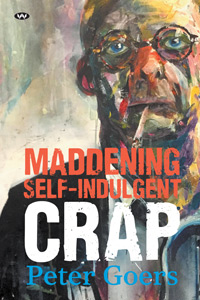
Maddening Self-Indulgent Crap – Peter Goers (Wakefield Press $34.95)
I don’t know Peter Goers, but after reading his book I wish I did. It’s the funniest book I’ve read in a decade and it’s full of the most wonderfully laconic Australian humor. Goers’ is an icon of South Australia - a broadcaster, columnist, theatre guru and critic. The book’s title comes from a review Goers once gave a Fringe show in the 80s and is indicative of the self-deprecating wit that permeates the text.
Goers credits his most important creative influence as being Barry Humphries, whom he first met as a 15-year-old in 1971 when he worked in the tableware department of John Martin’s department store. The book, which is only a bit of a memoir, gathers material from his Fringe shows, anecdotes about show-business royalty - Ethel Merman, Bette Davis and Angela Lansbury; friendships with Anne ‘Willsy’ Wills and Max Harris; selections from his Sunday Mail columns; and a whole chapter of daily observations, quotations, bits from books he was reading, and from his daybook since 2012.
As the publisher’s blurb says, it’s not only nostalgic but also poignant. He first trod the boards as the Artful Dodger in Oliver in 1971, and since then has worked in theatre on two continents as actor, director, designer, academic and entertainer.
There’s a lot to laugh at and a lot to love. He writes affectionately about being guest of honor at small-town lunches in community centres and town halls, plus his obsession with op shops. He once had a call from the local lady who ran his nearest op shop saying she had some clothes just in that were his size and perfect for him. They were perfect alright, as he discovered when he saw them - he had donated them to the shop the week before, so not to disappoint he bought them again.
His Friday night parties when he lived in Woodville became legendary. One time he’d just gone to bed at 6am when he was woken 30 minutes later with someone banging on his door. It was the girlfriend of a guest who had come to search for her partner’s missing teeth.
Goers lived in Istanbul, Turkey for 3 years and visited Gallipoli three times whilst he was there. His accounts of experiencing the Dawn Service are potently moving. In Turkey he directed a production of Clem Gorman’s A Manual of Trench Warfare with young Turkish actors. They’d translate a couple of pages in the morning and then rehearse them in the afternoon. He became suspicious as to whether words like f**k and c**t were being translated properly. He was right. Instead of ‘those f**king Turks’ they had translated ‘Those noble, brave misguided, but heroic Turks’.
On travel, he once took his grandmother back to Perth for a visit and carried her luggage. On enquiring why it was so heavy, she said she had a ‘side of lamb in there. The meat’s terrible in Perth.’
His Phyllis Diller quote is priceless - ‘I realized I was 18 years behind with the ironing so I buried it in the back garden.’ Likewise the front page story and photo of Gladys Moncrieff from the Rockhampton newspaper - ‘Our Glad Leaves Hospital With Orchids Pinned To Her Crutch.’
Toni Lamond was playing the sharp-shooter Annie Oakley in Annie Get Your Gun in Adelaide. She’d been invited to a wine tasting in the Barossa Valley and arrived back at the theatre not in showroom condition. On her first entrance she had to walk downstage and fire her rifle at a weathercock, whereby a stagehand pulled a cord and made it fall. This night she entered and aimed in completely the opposite direction. There was a very long pause before the stagehand realized what had happened and pulled cord to let the weathercock fall. Lamond saw it fall and grinned at the audience and said, ‘Ha! Ricochet!’
Goers was sitting in the back row next to two nuns at the Playhouse watching the flamboyant Frank Thring play Othello. Early in the second act Thring was alone on stage and someone started to groan in E row. The groans increased and were followed by a death rattle as the patron died. Thring, furious at the disturbance, flounced off-stage as the curtain fell. Later, after the body had been removed, the play resumed. One of the nuns sitting next to Goers whispered, ‘Isn’t it awful,’ to which he replied, ‘I know, Sister, I’ve never been in a theatre when someone has died.’ The nun said, ‘No, I don’t mean that. I mean the show.’
His love for thespians he has worked with affectionately extends to four pages of names, whilst he credits his father with introducing him to the films of the Marx Brothers, his lifelong joy.
His love of country towns is obvious but he reserves his highest praise for Broken Hill. In talking about the movie Wake in Fright he says, it’s a movie about isolation, riotous drunkenness, aggressive hospitality, moral degradation, sodomy, dust, dirt, heat, the desert, violence and two-up. In Broken Hill they think it’s a documentary. But his best story about the Silver City is about controversial journalist and writer Jack Marx coming to work there and staying in a motel in Oxide Street. He came down to Argyle Street to get his lunch, a double-cut roll, in a snack bar. The woman making it was the wrong side of 60, blowsy and wearing that classic Broken Hill hairdo of platinum blonde bouffant. Marx said to this woman, ‘I’m staying at a motel in Oxide Street and it’s a bit pricey. That hotel across the road here in Argent Street - do you know what it charges per-night?’ She looked at him and said, ‘I dunno love. I haven’t been a hooker for years!’
I love the Silver City! And I love Peter Goers. I can’t wait for Volume 2. The book comes with B&W photos and an index. A fabulous read!
Click here to order your copy at Book Nook
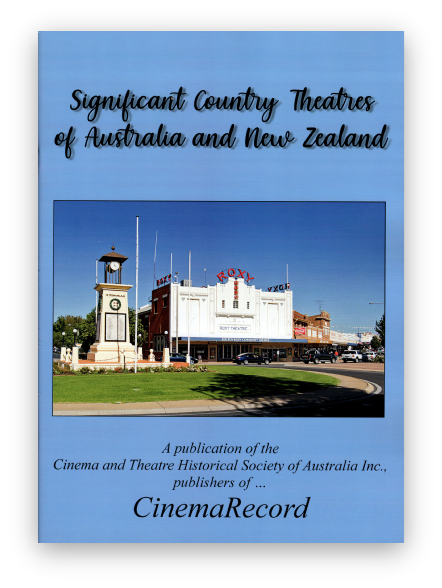
Significant Country Theatres Of Australia And New Zealand – Cinema Record (CATHS $20 includes postage)
This 60 page book is a marvelous pictorial record of 56 country theatres (mainly cinemas) in Australia and New Zealand, published by the Cinema and Theatre Historical Society of Australia Inc. Each page is dedicated to a particular theatre - some were converted from live theatres to cinemas, some cinemas have been converted to live theatres, and sadly some have been demolished.
The oldest is Ballarat’s Her Majesty’s Theatre, which was built in 1875 as the Academy of Music. Originally owned by businessman and philanthropist William Clarke, it became Her Majesty’s Theatre in 1899. Today it’s operational as a live performing venue.
The second oldest is the Gaiety Theatre, Zeehan, a former mining town on the west coast of Tasmania. Built in 1898 as a live theatre, it converted to silent movies in 1910, and sound in 1936. Today it’s part of the West Coast Heritage Centre, and operates as a pre-programmed tourist venue screening silent movies twice per day.
Launceston’s Princess Theatre was built in 1911 at a cost of 15,000 pounds by Marino Lucas, a vaudeville entrepreneur from Hobart. It originally screened movies because the backstage area was incomplete, but they were so popular the theatre continued as a cinema. It has been a ‘live only’ venue since 1998.
Toowoomba’s art-deco showpiece, the Empire Theatre, opened in 1911, but was gutted by fire in 1933. It was rebuilt in the then popular art-deco style and remained a cinema until 1971 when it became a Walton’s department store, and later a TAFE college. It’s now heritage listed and operates as a multi-purpose venue.
The newest performing arts venue is Araluen, Alice Springs, which was opened in 1984.
The illustrations, mostly in colour except for the demolished theatres which are B&W, are high-quality glossy. The text, though brief, is detailed.
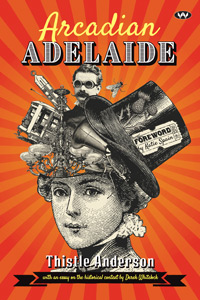
Arcadian Adelaide by Thistle Anderson. (Wakefield Press)
Satire has always had a home in Adelaide, from James McAuley and Harold Stewart’s greatest literary hoax of the twentieth century, the Ern Malley Affair, which they wrote in one day in 1943, skewering the modernist art and literary movement, to the Adelaide Fringe in the 60s when around every corner there was a revue with Lois Ramsay, to the present-day Adelaide Cabaret Festival, with Trevor Ashley displaying his diva bag of tricks. But who knew that as early as 1905, Thistle Anderson was sending up the establishment with her outrageous satirical swipes.
Arcadian Adelaide is a delightful, articulate and witty expose of Adelaide and citizens which Anderson, who was an actress, and whose real name was Mrs Herbert Fisher, called ‘The City of Juvenile Depravity’.
Published just a few years after women’s suffrage in Australia (which was led by South Australia in 1894), Thistle boldly went where few women went back in those times. She was outspoken and her bite was fierce. She revealed the City of Churches was ‘less holy than might be supposed’, with more opium dens and prostitutes per capita than Melbourne, and wines that are ‘the worst ever made’. She referred to the local men as ‘caricatures with inferior facial hair’ and local women as ‘cats’.
According to Katie Spain’s foreword, the closest we get these days to Thistle’s ‘deprecating drivel’ is ‘ABC Radio’s Peter Goers during one of his anti-Burnside rants or Barry Humphries in full Dame Edna Everage flight.’
The book also comes with an essay on Edwardian Adelaide by Derek Whitlock, which helps bring Anderson and her era into perspective. It’s a funny and fascinating slice of our literary history which was first re-published by Wakefield in 1985. A big hearty welcome for its return to our bookshelves. \
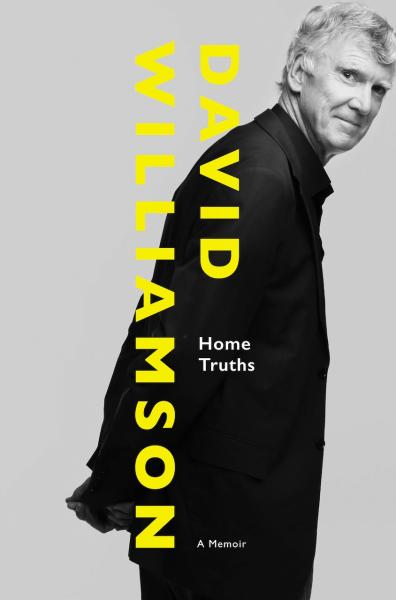
Home Truths
By David Williamson (Harper Collins). Reviewed by Peter Pinne.
David Williamson is Australia’s tallest playwright and its most prolific. With 56 plays to his credit, he’s way ahead of Shakespeare at 36, but behind England’s Alan Ayckbourn with 70. His new memoir Home Truths is a lively account of his 50+ year career - a warts and all tome with plenty of examples of Men Behaving Badly.
During his career, Williamson saw important political and economic changes happen in the country which resulted in every hot-button topic of the time finding its way into a Williamson play; anger about social issues made him write Sons of Cain, Sanctuary, The Great Man, Top Silk, A Conversation, Influence, Crunch Time and Family Values.
But like every good writer, he wrote what he knew with most of his characters middle-class Anglo-celtic, with masterful exposes of the ‘chardonnay and canapés’ set.
Born in 1942, five days after the Japanese bombed Darwin, to a mother Elvie, an expert in emotional blackmail, and a father Keith, the exact opposite. The satiric impulse to hurt in his writing came from his mother, whilst the impulse to forgive came from his dad. Elvie was fiercely competitive and a ‘seething cauldron of hostility’, who grew up in poverty in Brunswick. She worked at Adams cake shop when she met Keith, who was a bank clerk and engaged to Deborah at the time. He was also a liberal voter, a mason, and an amateur footballer who, despite them being a Catholic team, was a rabid Collingwood supporter.
Williamson acknowledges the vulgarities he heard at the matches as a kid proved in later years to be comic gold in his plays. With his parents continually in conflict, home life was a constant drama. Williamson portrayed it thinly disguised but ‘close to reality’ in After the Ball.
At a dinner party, Williamson and Barry Humphries b discussed the ‘uncanny parallels’ of their mothers. Humphries turned his into an ‘international industry’, but Williamson only used his sparingly. When his father was posted to Bairnsdale, Williamson’s teacher at his new school, Alan ‘Boof’ McLeod, instilled a love of Shakespeare into him (Julius Caesar/Macbeth), whilst the 1967 Melbourne Theatre Company production of Arthur Miller’s Incident at Vichy was his epiphany moment when he knew he wanted to write drama. But that was a long way off.
After stints at University High School, where he was exposed to Leftie views, he studied mechanical engineering at Monash and graduated. He got a job at General Motors Holden where he designed a handbrake that didn’t work and read Chekov (his favourite playwright) under the desk.
In 1965 he married high school teacher Carol and they lived in an A.V. Jennings clinker-brick veneer in Bundoora. Another former college mate Mike Hanson and his wife Bea also lived there so there were inevitably many parties. One of them became Don’s Party, and Hanson became the prototype for Mal, who had an ‘obsession with penis size not unlike Mike’s.’ When Hanson saw it he was not amused and neither was his wife. It led to Williamson realizing if he was going to draw from life he had to be a little more aware of the possible damage it could do. He began to show his scripts to anyone who might be pilloried to get their approval.
After stints writing for the Engineers’ revue, and a fruitless bout attempting to write novels, he finally wrote a short, tough, play about bullying, You’ve Got To Get On, Jack, inspired by his work-experience in a Tasmanian mining town. The Indecent Exposure of Anthony East was his first play produced by Tin Alley Players in 1968, but You’ve Got To Get On Jack, written before Anthony East, was his first play to tread the boards at La Mama, where it received a ‘humiliating’ for Williamson reading, but later a full production in 1970.
Then came The Coming of Stork at La Mama, Don’s Party at the Pram Factory, and the biggest hit of all, The Removalist at La Mama. Carlton was now home to Williamson! He was the golden boy of Australian drama and soon his plays were appearing, not only in the alternative venues, but, on the main stages around the country.
In 1972 MTC finally mounted a Williamson play, his indictment of the Vietnam War, Jugglers Three, and in 1973 he had his first London outing when Jim Sharman directed The Removalists at the Royal Court. Two years later Michael Blakemore did Don’s Party at the same venue.
But his biggest London success was in 2002, with his Sydney art market expose Up For Grabs, with pop-diva Madonna. Williamson was summoned to London before rehearsals started because she wanted some ‘changes’. He spent a week with her, changed the setting to New York instead of Sydney, upped the ante from a two million painting to a $20 million Jackson Pollack, and softened the ending to accommodate her wishes. It resulted in his biggest West End success.
It was also Blakemore who facilitated Williamson’s first outing on Broadway, when he mounted an eight-week production of The Club, starring Fred Gwynne from The Munsters. During the seventies and eighties, despite a punishing schedule of writing a play a year, Williamson also penned a lot of screenplays, the most notable being two Peter Weir successes, The Year of Living Dangerously with Sigourney Weaver and Mel Gibson, and Gallipoli also with Gibson and Mark Lee.
The Williamson brand became sure-fire box-office. Audiences loved him but critics were not always favorable. Strident left-wing Sydney writer Bob Ellis began a feud with Williamson that lasted until Ellis’ death.
Williamson’s plays had been annually produced at the STC, but suddenly with Cate Blanchett and husband Andrew Upton’s new broom, he was persona non gratis. They did not want to rely on a David Williamson play to ‘ensure their financial bottom line’.
Williamsom had written Nothing Personal for Blanchett and Robyn Nevin, but when he showed it to Nevin she was so stunned by it she asked he delete it from his computer. Unknowingly he’d obviously hit too close to the bone of reality. Blanchett reluctantly organised a reading of it, but it never saw the light of day at the STC.
It was later produced at the Ensemble, who now premiered all his new plays, with Greta Scacchi and was a big hit.
It was during the original run of The Removalist at La Mama that Williamson hooked up with his second wife, Kristin Green, his first being pregnant with their second child. Kristin was a primary school teacher, an actor, and also a theatre critic for the well respected Melbourne Times. When his first marriage broke down, he married Kristen, and they later moved to Sydney. Kristin became a full-time journalist, columnist, and wrote novels, and then infidelity entered the marriage. Both were guilty but they worked it out and today remain closer than ever.
Noosa became their favored getaway destination and they eventually moved there and became involved in the local arts scene, creating Noosa Long Weekend which morphed into Noosa Live! His punishing work schedule resulted in Williamson suffering from severe heart problems later in life. He warmly talks a lot about family and his affection for them shines through in the truth of the reminiscences.
The saddest day of Williamson’s life was when his father died and he and his brother Peter looked at his father’s wallet and saw on the inside flap a photo of a pretty young woman with a warm smile. ‘It was Deborah, the woman he knew he should have married, the woman my mother knew he regretted not marrying. He’d endured fifty eight years of married hell.’
When his mother was dying in hospital she looked Williamson in the eye and asked him if he ‘loved her.’ When he hesitated for a second, she had her answer and the tears started to well in her eyes. It’s these personal anecdotes that give the book its depth. Funny, relatable, and richly rewarding. Highly recommended.
Click here to order your copu of Home Truths at Book Nook.
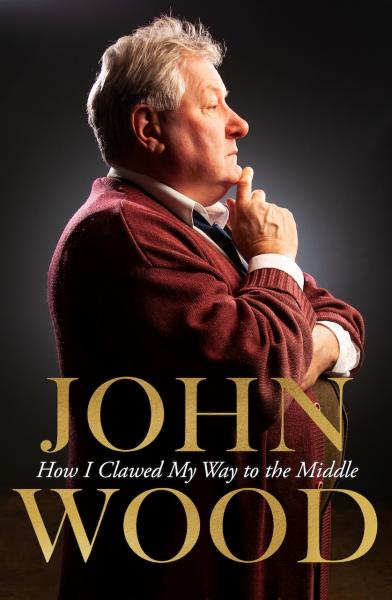
John Wood – How I Clawed My Way To the Middle (Penguin/Viking $22.00)
In the first pages of his new autobiography, John Wood refers to himself as a ‘jobbing actor’, and after reading it I’d have to say a ‘jobbing actor’ who’s had a rich career. Yes, there has been a lot of bread-and-butter work but there has also been incredible success on stage in everything from Shakespeare to David Williamson, with musicals in between, and TV, in the long-running Rafferty’s Rules and Blue Heelers.
Wood grew up in working-class suburb Port Melbourne, in his youth and later moved to Croydon. The thing he remembers from that time is suburbia was gray, flat, and, where they lived in Croydon, without sewerage. His father had been a POW in the war, was scarred by his experience, and worked at the Flemington abattoirs. Wood did a stint there (the pay was good - £21 per week), and also worked as a brickie’s labourer, a machine press operator, and a clerk at the Victorian Railways.
He had a brush with several religions, but didn’t find one to suit, joined the scouts, and like all youths had a fling with séances and ouija boards.
In school he played The Defendant in Gilbert and Sullivan’s Trial By Jury, and then joined the Melbourne Youth Theatre, which was set-up by John Ellis and Lois Smith. Other members of the group included Max Gillies, Wendy Hughes and Tony Taylor. They did Brecht’s Caucasian Chalk Circle, but when the success of the group saw them become possible rivals for the Melbourne Theatre Company, John Summer was instrumental in having their funding removed.
It was during his MYT days that he met his wife Leslie, who at that time was attending Monash University. It was a time of The Beatles, The Rolling Stones, Vietnam demonstrations, draft dodging and long hair, and Wood had the longest, as a front-page cover of Truth confirmed. Wood fortunately missed out on being called up. His father was vehemently anti-conscription due to his own war experiences.
Lois Smith encouraged Wood to audition for NIDA, which he did singing the Defendant’s song from Trial By Jury. Despite not having completed his schooling, he was accepted. His co-students were Kim Carpenter, Nigel Triffitt, Joanna McCallum and Aubrey Mellor. Wood was awarded a scholarship of $6 per fortnight by the NIDA board, and to earn extra money he became a follow-spot operator at the Music Hall, Neutral Bay, Sydney. During his time at NIDA he performed in Our Town, King Lear, The Rivals and The Crucible.
On graduation he was offered a contract with the Old Tote Theatre Company, where he did Death of a Salesman, Major Barbara, and Oedipus Rex, directed by Tyrone Guthrie. Guthrie wanted him to go to Melbourne for his MTC production of All’s Well That Ends Well, but Robin Lovejoy nixed it, promising him the lead in The Hostage, but reneging and instead giving it to Terry Bader.
He also started to get TV offers - parts in Barrier Reef, Dynasty, and Catwalk followed - before he joined the newly created Nimrod Theatre, where his credits included Flash Jim Vaux, Hamlet On Ice, and his own self-penned On Yer Marx.
On returning to Melbourne to fulfill an MTC contract, and now married to Leslie with their first child Meg in tow, they settled at Ferny Creek in the Dandenong Ranges. His days were spent writing for Cop Shop, The Sullivans and Prisoner, whilst his nights were on stage in John Power’s The Last on the Knucklemen, one of the biggest successes of his career. He was memorable as Sugar Renfrey in the ABC’s Power Without Glory, Alan Bond in The Challenge and Robert Menzies in The Last Bastion, before he was cast as Michael Aloysius Rafferty in Rafferty’s Rules.
The show ran five years and brought him Most Outstanding Actor of the Year at the Logies in 1988 and 1989. Then came the role of Tom Croydon in Blue Heelers, which ran for 12 years. After nine years of being nominated for a Gold Logie, Wood finally won it in 2006, the year the series was cancelled.
He had stints in Adelaide (in Patrick White’s Signal Driver), Brisbane, and appeared in Jim Sharman’s 1990 production of Chess. Other musicals included She Loves Me, Dirty Rotten Scoundrels and My Fair Lady. His last performance before the Covid shutdown was in Crunch Time, David Williamson’s last play at the Ensemble Theatre, Sydney in 2020.
It’s a marvelous memoir - a good read, with short, clear, concise chapters that bristle with wit.
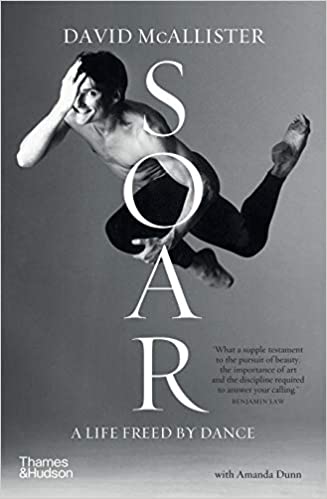
SOAR – A Life Freed by Dance (David McAllister) (Thames & Hudson $29.95)
A young boy’s vision of becoming a ballet dancer comes true beyond his wildest dreams in David McAllister’s new autobiography about his career at the Australian Ballet. From growing up in Perth in a devoutly Catholic family, being bullied at school and called a ‘pooftah’ and ‘pansy’, being accepted into the Australian Ballet School, dancing as a coryphee, becoming a principal, winning a Bronze Medal in Russia, being feted in Australia and internationally, to taking on the mantle of Artistic Director, McAllister has done it all.
This book lovingly captures the highs, the heartbreak, and the incredible work ethic that drove him.
As a child he was obsessed with dance and loved the ABC’s Play School. He pestered his parents to let him take ballet classes, but it wasn’t until they saw Rudolf Nureyev dancing Don Quixote on TV that they agreed.
Being the only boy in a class of girls didn’t deter him. He was in his element. He was one of the kids in The Nutcracker for Perth City Ballet, and played Nancy in his school’s production of Oliver!
When he was accepted for the Australian Ballet School in Melbourne, his parents said he could not go until he finished his HSC. One year later he packed his bags and moved to Melbourne. It was a time of share houses, study, classes and parties. He had a secret affair at 19 with AB’s principal dancer Kelvin Coe, but when Coe wanted to make it public McAllister backed off, not ready to acknowledge he was gay. He didn’t actually come out until he was 46, long after his younger brother Paul, who was also gay, had declared his homosexual feelings.
In between, McAllister climbed the heights, despite thinking himself too short for the leading ‘Prince’ roles, and Maina Gielgud suggesting he get a ‘nose job.’ His partnership with Elizabeth Toohey saw them win a Bronze Medal in 1984 at the Fifth International Ballet Competition in Moscow. They not only became the toast of the town but were invited back to perform an incredible three times. During this time they also became a couple, his first ‘straight’ relationship.
A 1992 tour which took in Italy and London saw him dance Coppelia at London’s Coliseum, where he got to meet Princess Diana at the after-show party. He became Artistic Director of the company in 2000. His tenure in the post has often been criticised as being too safe, which he acknowledges, though also pointing out he was responsible for commissioning Graeme Murphy to create a new Swan Lake in 2002, which successfully toured to London three years later. He was also responsible for Christopher Whelan’s Mercurial Manoeuvres, John Neumeier’s Nijinsky, and created his own version of The Sleeping Beauty in 2015.
Co-authored with journalist Amanda Dunn, the book is refreshingly free of bitchy gossip, and is not one of those ‘get even’ tomes. If anything, it’s sweet and old-fashioned.
McAllister has been with the company for almost 40 years, something that used to happen back in grandfather’s day: you’d leave school, get a job in a bank and stay there until you retired and they gave you a gold watch. I don’t know whether McAllister will get a gold watch, but he’s certainly earned it.
About Peter Pinne
Peter is an author, playwright, composer and record producer.
12 of his musicals are available for performance. Click here for more details.
